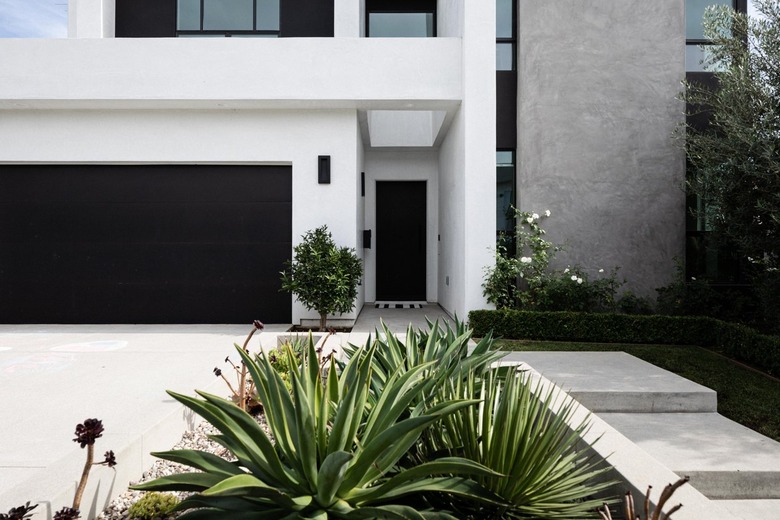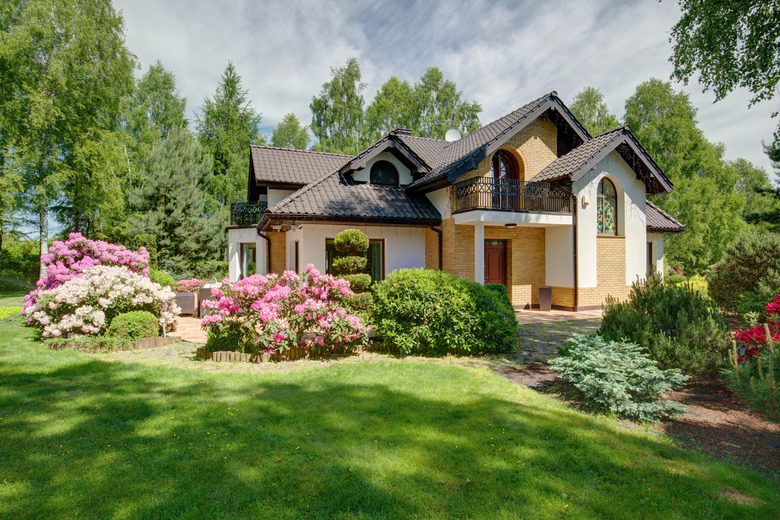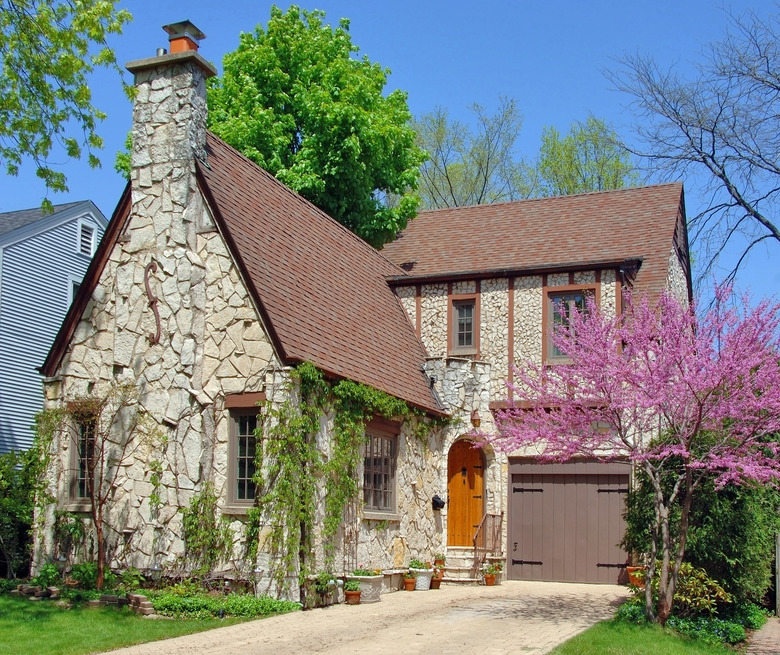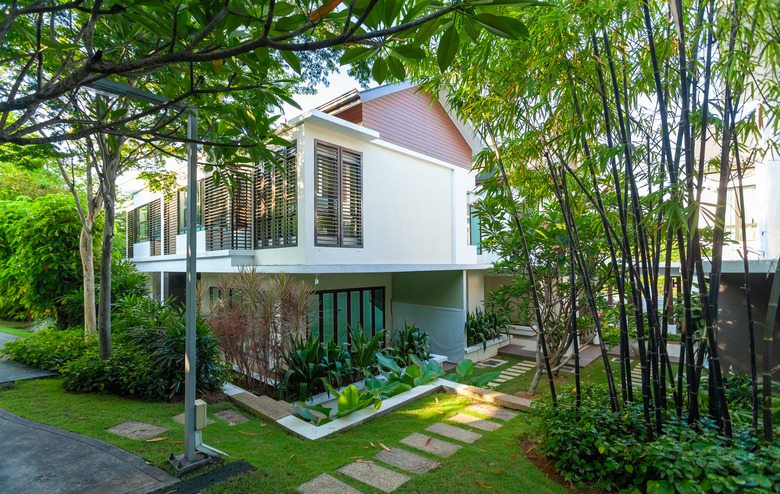How To Choose And Use Foundation Plantings
We may receive a commission on purchases made from links.
Foundation plantings are typically shrubs, small trees and ground cover. They serve several purposes as far as your house and property are concerned, but they aren't there to dominate or be particularly showy and detract from other elements of your landscape. As Get Busy Gardening points out, they should enhance your home's appearance without stealing the spotlight.
A practitioner of feng shui, the Chinese art of property harmonization, would say that foundation plantings should improve the flow of energy, or ch'i, around your house. Characteristics that contribute to their ability to do that include coloration, shape, size, texture and vitality. Plantings in the front yard should particularly draw attention to the front door, which is the gateway through which ch'i enters your home, while those in the back and on the sides offer protection and visual definition.
The wrong foundation plantings or those unsuitable for your climate detract from your home's visual appeal and ultimately its value, but on the flip side, Monrovia states that a well-landscaped front yard can increase your home's value by as much as 11 percent. That in itself is motivation for investing in a good foundation garden design, but it isn't the only one.
Why Your House Needs Foundation Plantings
Why Your House Needs Foundation Plantings
It's rare to find a house without any foundation plantings, but if you do, you'll probably notice how barren and morose it looks, as if something is missing. The straight lines formed by a building foundation contrast in an unfavorable way with the surrounding earth, and foundation building materials tend to look incongruous with their surroundings when they are completely exposed. Think of foundation plantings as a frame for the house that reinforces the natural surroundings while enhancing the house itself and helping it to blend in.
Foundation plantings also serve a practical purpose by protecting your home from the elements. Well-placed shrubs block the wind in winter and keep the house warmer, and small trees provide shade for exposed parts of the home and keep it cooler in summer. It's important to be careful when choosing and placing trees and shrubs, though, to avoid having them block windows or encroach on the foundation or the rest of the landscape, which could turn out badly for your view from inside, the overall landscape design and the structural integrity of the house.
Plan Foundation Plantings Before You Buy
Plan Foundation Plantings Before You Buy
It goes without saying that you want plantings that can thrive in your climatic zone, and the best way to ensure that is to buy them at a local garden center, particularly one that specializes in native plants. You might even consider using some of the species that are already growing and thriving elsewhere in your yard. Climatic zone isn't the only factor that guarantees a good garden, though, so it's worth the effort to draw a schematic that shows the following information at a glance:
- Overall available space: Measure the length and width of each bed, remembering to allow a healthy space between the plantings and each other as well as the house to avoid encroachment. As a rule of thumb, keep a minimum of 3 feet from the house for small shrubs and 5 feet for larger ones.
- Sunny and shady areas: This may require a separate chart in which you catalog the number of hours each part of your house is in full sun, partial sun or shade each day. Spend the entire day making the chart and update it every hour. If you can't be at home all day, you can also program a time-lapse camera to take hourly shots or use a garden light meter.
- Architectural features that need special consideration: Mark all the windows on your chart so you'll remember to put low-growing plants in front of them. Note stairways, doors and special features, such as pillars or alcoves.
- Soil condition: The soil near the foundation isn't always the best soil for planting given that it's likely to contain stone, gravel and concrete from building the foundation. If you purchase a three-in-one light meter, you can use it to test soil pH and moisture. It's also a good idea to take a few samples to a garden center or your local cooperative extension service to test for nutrient content.
Choosing Foundation Plantings by Shape
Choosing Foundation Plantings by Shape
Shapes are an important element of foundation plantings, and it's good to mix them, says Garden Gate. A variety of common shapes, such as rounded, columnar, horizontal and pyramidal, provides balance and is preferable to an overuse of one in particular, which usually looks strange. You can also use weeping plants to draw attention away from a defect higher up on the house, such as an old roof or a misplaced window. Some examples you can use in most USDA hardiness zones include:
Rounded
- Dwarf blue spruce (Picea pungens 'Glauca Globosa') grows 3 to 4 feet tall and 4 to 6 feet wide in USDA hardiness zones 2 to 7 and has bluish needles.
- Smooth hydrangea (Hydrangea arborescens 'Annabelle'), which grows in zones 3 to 9, reaches a mature height of 3 to 5 feet and reaches a width of 4 to 6 feet.
Columnar
- Emerald green arborvitae (Thuja occidentalis 'Smaragd'), hardy in zones 2 through 7, grows 12 to 15 feet in height and only 3 to 4 feet wide.
- Ginkgo (Ginkgo biloba 'Princeton Sentry') grows in full sun in zones 3 to 8, and with a mature height of 40 to 50 feet and a width of 20 to 30 feet, it is a great shade-giving accent for the corners of flower beds.
Horizontal
- Creeping juniper (Juniperus horizontalis 'Blue Chip'), reaches a height of only 12 inches but stretches out as far as 10 feet. Hardy in USDA zones 3 to 9, it has blue foliage and works well in front of windows and on top of low walls.
- Pagoda dogwood (Cornus alternifolia), a tree that thrives in zones 3 to 7 and grows to a height of 15 to 25 feet and a spread of 20 to 30 feet, brings springtime color to the front of the house with its creamy-white flowers.
Pyramidal
- Dwarf Alberta spruce (Picea glauca 'Conica') is a slow-growing evergreen shrub that grows 10 to 12 feet tall in 30 years and 3 to 5 feet wide in full sun or partial shade in zones 3 to 7.
- Japanese yew (Taxus cuspidata 'Capitata') has dark-green needles and can grow very large, with a height of 25 feet and a width of 10 feet. It grows in zones 4 to 7.
Weeping
- Weeping Norway spruce (Picea abies 'Pendula') grows about 15 feet tall and 15 feet wide and has drooping, dark-green needles. Hardy in zones 3 to 7, it prefers full sun.
- American wisteria (Wisteria frutescens) is a native climbing vine that needs a trellis on which to grow, because it may reach a height of 40 feet. It's hardy in zones 5 to 9 and adds color to your landscape in spring with its purple-blue flowers.
Add Some Color
Add Some Color
Many people confine their choices to evergreens because they keep their foliage year-round, but if you do that, you miss out on the coloration and interest of deciduous shrubs and perennials. A good rule of thumb is to plant 50 percent evergreens to provide a structure along with 25 percent deciduous shrubs and 25 percent perennials for color. Layering plantings with taller evergreen shrubs in the back guarantees year-round coverage while providing seasonal splashes of pizzazz.
Trees are best for accenting the corners of the garden, and as a rule, they shouldn't be too close to the house to avoid problems with roots. Some colorful candidates that add curb appeal include:
- Eastern redbud (Cercis canadensis, zones 4 to 9), which literally glows with pink coloration in spring from the flowers that appear before the foliage.
- Japanese maple (Acer palmatum, zones 5 to 8), which adorns the yard with bright-red foliage in autumn and makes a perfect companion to evergreen shrubs.
- Star magnolia (Magnolia stellata, zones 4 to 8), which can be trained into a shrub and placed next to a garden wall or walkway to make full use of its showy white flowers that arrive in early spring.
Ground cover typically provides the background for more showy landscape elements, but flowering varieties can also play a starring role. Consider:
- Bugleweed (Ajuga reptans, zones 3 to 10), a member of the mint family that has blue and white bugle-shaped blossoms and grows in sun or shade.
- Windflower (Anemone canadensis, zones 3 to 8), another attractive ground cover with white and yellow flowers.
- Hosta (Hosta spp., zones 3 to 8), a garden ground cover mainstay with large purple, lavender, white, or even streaked flowers that bloom all the way into July.
Flowering shrubs add the finishing touch to your foundation and should be chosen with an eye to the house colors. You're looking for matching, analogous colors rather than contrasting ones because you want your home to look comfortable and settled in its surroundings.
- Azaleas belong to the genus Rhododendron and include both deciduous and evergreen varieties that grow best in zones 6 to 9, although some will grow as far north as zone 4. The showy flowers can be white, pink, red, yellow and even orange depending on the species. They are low maintenance and easy to shape, but like rhododendrons, all plant parts are toxic and they aren't a great choice around pets or children.
- Summersweet (Clethra alnifolia, zones 3 to 9) is a slow grower with sinewy white or pink flowers that attract bees.
- Burning bush (Euonymus alatus, zones 4 to 8) brings a riot of crimson color into your yard in the fall to brighten up the days heading into winter. It's worthy of note, however, that this species is considered invasive in many states, including the Midwest and South.
Tips for Planting a Foundation Garden
Tips for Planting a Foundation Garden
Before you start digging, be sure to call 811, the national "call before you dig" hotline, to get a map of underground utilities on your property. This is especially important when digging near the house because there are bound to be water and drain lines in your way, and if you damage one without checking first, you could have an expensive repair on your hands. If the land slopes toward the house, there may be an underground drainage system in place that isn't on file with the utility companies, so watch for that too.
Always consider the mature size of the trees and bushes you plant and provide space for them to grow. Too many plants crowded together looks and feels uncomfortable. Add some hardscape features to add definition to your foundation plantings.
Adding mulch of gravel or bark to mimic and reinforce the colors of the house and a low wall or walkway can complement the building's architectural design. Take caution against covering the architectural features completely because the design looks best when the house and garden appear to be part of each other, and neither would be complete without the other.



